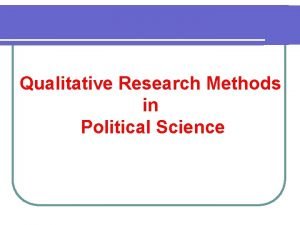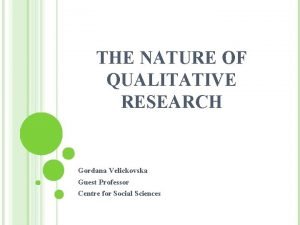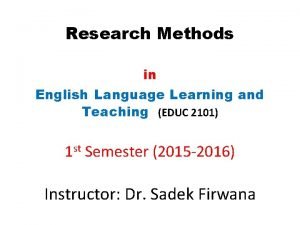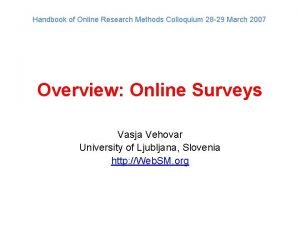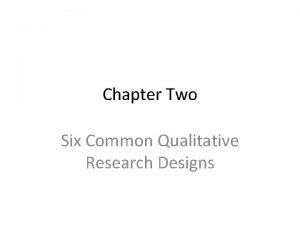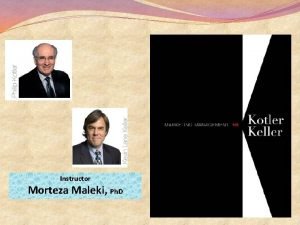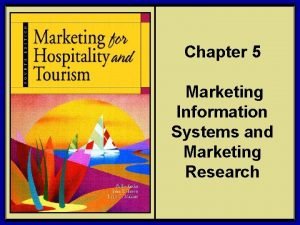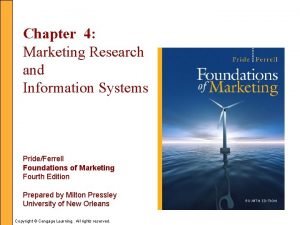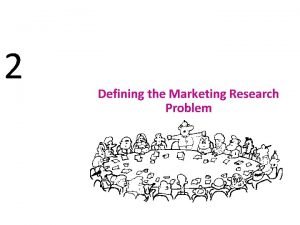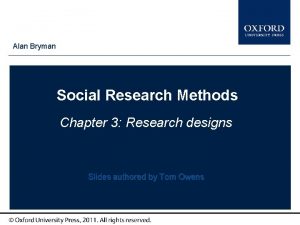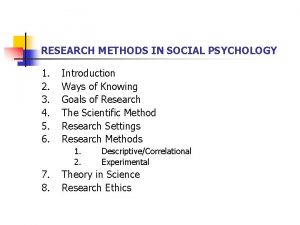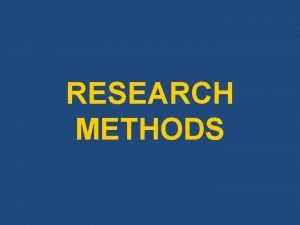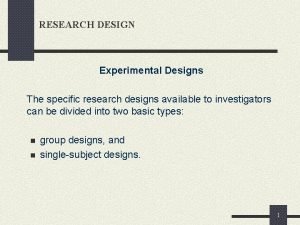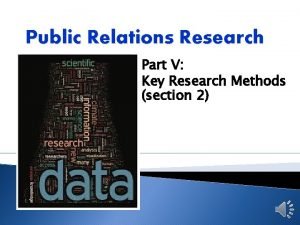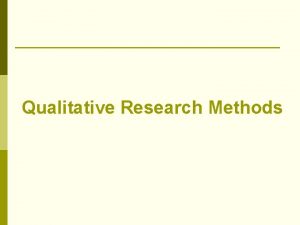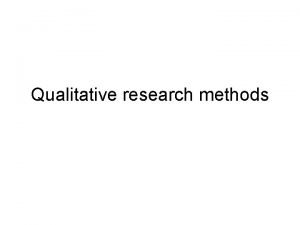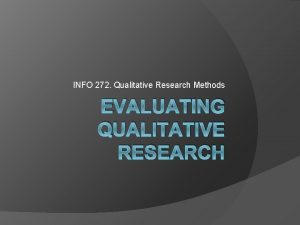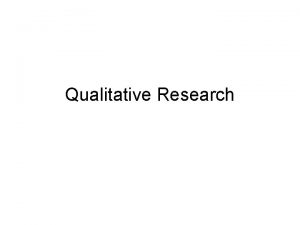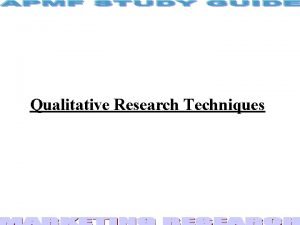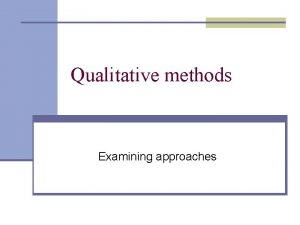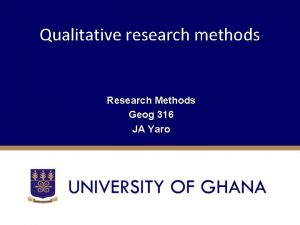Qualitative Research Methods in Marketing Types of Qualitative

































- Slides: 33

Qualitative Research Methods in Marketing ”Types of Qualitative Research” Sammy Toyoki Hedon Blakaj

Session Agenda • Overviewing qualitative research “methodologies” and “methods” • After this session, you should be able to: – Understand the difference between methodology and method – Have a basic grasp of the main methodologies in qualitative business research – Have a basic grasp of the various kinds of qualitative methods – Be able to select a suitable methodology and method for your research topic

Have you identified a research topic? • If so, what is it? • If not, do you need help?

The main methodologies in qualitative research

Starting point • What is ‘methodology’? • The rationale and the philosophical assumptions that underlie the research and guide the choice of research questions and the methods that are used for data collection and analysis

Simplifying distinctions • There is a clear difference between ‘positivism’ and ‘constructionism’ • However, making clear distinctions between sub-categories of constructionist methodologies is not that easy (they overlap) Guba and Lincoln 1998

Unravelling some key dimensions of qualitative methodology • Once we examine the different approaches within the qualitative field – there are no simple distinctions to be made • Having said this, it is more useful to understand constructionist methodologies as sharing one another’s assumptions through different combinations • Today, we will try to discuss what kinds of combinations there and why

Unravelling these overlapping methodologies. . . • • • What is constructionism? What is interpretivism? What is hermeneutics? What is constructivism? What is cultural research?

What is constructionism? • Constructionism is commonly understood to be an overarching label for qualitative research that focuses on how social reality is ‘constructed’: – in a given context (place and time); – by one or more individuals (i. e. through interaction); – under the influence of diverse and transforming conditions (e. g. meanings; situations; goals; understandings; values, cultural practices. . . and so on In one sense or another, all qualitative research is constructionist!!

What is constructionism?

What is interpretivism? • Interpretivism is a constructionist approach that focuses on individuals’ lived experiences – and the meanings individuals attaches to such experience • Lived experience refers to immediate, embodied, practical experience (e. g. what is it like to ride a motorcycle or jump out of a plane with a parachute) • Thus, interpretivism seeks to understand (i. e interpret) how individuals construct meanings of their situated lived experiences Note: the direct study of ‘lived experience’ is what phenomenology aims for

What is interpretivism? • • Proponents of this persuasion share the goal of understanding the complex world of lived experience from the point of view of those who live it. This goal is variously spoken of as an abiding concern for the emic point of view (i. e. individual perspective), for understanding meaning, for grasping the actors definition of a situation, The interpretivist believes that to understand this world of meaning one must interpret it. The inquirer must elucidate the process of meaning construction and clarify what and how meanings are embodied in the language and actions of social actors. (Schwandt 1994: 118) But what makes interpretivism distinct from other constructionist methodologies is its strong emphasis on ‘hermeneutic analysis’

What is Hermeneutics? • Hermeneutics is how we as individuals (and as researchers) interpret phenomena on a part-whole basis • The main principle that characterizes hermeneutics as a methodology is that we interpret (and hence, ‘understand’) by foregrounding and backgrounding phenomenon • Thus, hermeneutics is a dimension of both interpretivism and constructionism (e. g. construction and interpretation of meaning happens hermeneutically) • Because all human understanding is based on this principle – it follows that all qualitative approaches are also, to some extent, hermeneutic!!

What is Hermeneutics? • It simply refers to the idea that we may come to know something only by recognizing it against a wider background of human activity (Harre and Gillett 1994) • For example, the only way in which we may understand the behaviour of a person is by comprehending the contextual meanings that are informing that persons activities (Wittgenstein 1959) • The central metaphor for hermeneutic analysis is the ‘hermeneutic circle’ (Gadamer 1960) – referring to iterative movement between ‘parts’ and ‘whole’ until a context is ‘grasped’

Hermeneutic Analysis • The objective of a hermeneutic analysis is to “build” theory that is at once faithful to the participants point-of-view – but also reflective of the broader cultural context that might influence this point-of-view. • The idea is to use abductive logic (‘filling in the blanks’) and ascertain themes, structures and dynamics that might constitute the given point-of-view, phenomenon, or context • The purpose is to highlight tacit and taken-for-granted knowledge by bringing it to the foreground (focus is on practices and underlying cultural assumptions)

What is constructivism? • If ‘constructionism’ has a general interest in ‘how social reality is constructed’. . . constructivism focuses specifically on how such reality is constructed through language. • A simple rule of thumb to distinguish constructionism and constructivism: – Constructionism takes for granted the implications of linguistic construction of reality (e. g. authorship; discourse; power) – Constructivism, in turn, takes such implications as its starting point (i. e. issues such as authorship, discourse and power are of central analytical focus)

What is Cultural Research? • “Cultural” research is a highly ambiguous label (depending on the who is defining it) • Rule of thumb: cultural research focuses on how the culture of a given context shapes action, meaning, events etc. – and vice versa – how such actions, meaning or events, in turn, shape culture

What is Cultural Research? • Cultural research can be: – Constructionist (e. g. understanding how individuals construct their social reality through culturally informed practices) – Interpretive (e. g. understanding how individuals give meaning to their lived experiences in given cultural contexts – Constructivist (e. g. understanding how individuals’ linguistic practices are shaped by a given cultural context) – Hermeneutic (e. g. understanding these practices, experiences, meanings and language use against a relevant broader background of significance)

Different qualitative research methods

Recap: What is Method • In a strict sense, method refers to the ways of collecting and analyzing data • Each method is usually underlined by a primary methodology (set of philosophical assumptions) – but often consists of features from other methodologies as well… • Remember: There are no straightforward categories for methodologies and methods. In most cases, scholars apply those philosophical assumptions (’methodology’) and ways of doing research (’method’) in ways that best suit their research contexts and aims • The challenge, then, is knowing which methodologies and methods are commensurable with one another (i. e. philosophically consistent)

Some of the methods in qualitative research • • • Case study Ethnography Grounded theory Focus group research (see Eriksson and Kovalainen 2008: Part II) Action Research Narrative research Discourse analysis Feminist research (“Critical research” left out) Practice-theoretical research (Schatzki 1996; 2002) Phenomenology (Thompson, Locander and Pollio 1989 a; 1989 b)

Case study • Central feature: the construction of a ‘case(s) (bounded real-life context) • Formulating research question(s): always related to the understanding and solving of the case • Main purpose (axiology): investigating the case ‘holistically’ in relation to its historical, economic, technological, social and cultural context (and to grasp what is ‘intrinsic’ about this particular case) • Levels of analysis may include the individual actor or group of actors (e. g. focus on lived experiences/narratives), or an on-going process such as a management project (e. g. focus on development of normative management practices over a certain period of time) • Methodology (multiple): constructionist; interpretive; hermeneutic; constructivist; cultural (but often just ‘realist’) • Methods (multiple): ethnography; interviewing; grounded theory; analysis of texts etc.

Ethnography • Central feature: The study of cultures and cultural sense-making through different forms of observation in actual situations • Formulation of research question(s): No standard templates. Often asks how a given culture or cultural context is structured and enacted through cultural practices (e. g. habits; routines; rituals; norms; actions; values, beliefs. . . ) • Main purpose (axiology): Understanding daily life from the ‘inside’ (from the ‘natives’ perspective) • Levels of analysis: Traditionally ‘emic’ (the individual’s point of view) – but in contemporary cases extending to the etic (interpretation of individual practices against broader cultural or historical context • Methodology (multiple): constructionist; interpretive; hermeneutic; constructivist; cultural • Methods (multiple): participant or non-participant observation; interviewing; field notes; photography; videography; analysis of secondary documents etc.

Grounded theory • Central feature: Building of theory through specific analytic procedures • Formulation of research question(s): No standard templates. Depends on overarching methodology • Main purpose (axiology): Theorizing from collected data using a highly formalized coding process (open coding; axial coding; selective coding). Iterating between theory and data using this process until a coherent theory emerges. • Levels of analysis: Middle-range (not the individual level nor the societal level but meso level, that which is in-between, ‘specific social phenomenon’ e. g. subcultural practice of ‘skateboarding’ • Methodology: induction; deduction and (abduction), or, constructivist abduction • Methods: creating a tentative model for directing coding; data-collection; coding; creating categories; constant comparison; theoretical saturation; integration of theory

Focus group research • Central feature: A group of individuals discuss together, through their personal experiences, a topic selected by the researcher • Formulation of research question(s): Following the constructivist paradigm, appropriate research questions ask, for example, “how do consumers talk about Colgate toothpaste (if it were a focus group on this product)”? • Main purpose (axiology): Understanding how people interact with one another and construct meanings together. Understanding interactional dynamics of various kinds • Levels of analysis: Social; group level • Methodology: Constructivist (when academic); realist (when done for business purposes) • Methods: planning of group compilation; recruitment; group facilitation; contentanalysis/ethnography

Action Research • Central feature: Close collaboration with the research object/subject (a group, community or organization), solving practical problems as part of the research process • Formulation of research question(s): Formulated to address practical problems, e. g. How to market Valio’s dairy products in the Russian market? • Main purpose (axiology): Researchers perform as outside facilitators of change, fostering reflection over the change, while also doing a specific case study or set of studies • Levels of analysis: middle-range (meso); macro • Methodology: constructionist; constructivist (but can be also realist) • Methods (multiple): ethnography; focus groups; interviewing; action-experiments; participant-written cases and narrative

Narrative research • Central feature: Studying how people tell stories and through such story-telling construct their selves, reality, interpreting and understanding shared meanings • Formulation of research question(s): Following the constructivist methodology, appropriate research questions ask: ‘How do people tell stories about so and so. . . ? ’, or, ‘What kinds of stories do consumers tell about their experiences with Valio milk? ’ • Main purpose (axiology): Understanding how sense-making happens through story -telling (self; identity; life-story; narrative coping techniques; structural analyses) • Levels of analysis: individual; group; organizational; cultural narratives • Methodology: constructionist; interpretive; constructivist (but also realist, postmodern and post-structural) • Methods: narrative analysis; analysis of narrative; antenarrative analysis

Discourse analysis • Central feature: Understanding how people are conditioned by discourse. ‘Discourse’ provides the vocabulary, expressions, and style of thinking and talking about a given subject. Thus, discourse also reproduces cultural meanings • Formulation of research question(s): Following the constructivist methodology, appropriate research questions ask: How do people talk about so and so. . . ? ’ What kinds of discourses are prevalent in context Y? • Main purpose (axiology): Multiple, e. g. understanding how discourse creates ‘truth’, ‘legitimacy’, power relations, self-surveillance (Foucaldian discourse analysis), or, how discourses are historically and/or culturally specific, moulding particular forms of marketplace and practices therein (e. g. Craig Thompson’s consumer research studies) • Levels of analysis: individual; group; community; institutional; societal; mythic • Methodology: constructivism; interpretivism (i. e. hermeneutics) • Methods: interviews; focus groups; different kinds of ‘text’ (media; commercial; legal; political; ethnographic etc. ); grounded theory; analysis of narrative

Feminist research • Central feature: Understanding how ‘gender’ plays out in production of social phenomenon (e. g. feminist vs. masculine stereotyping in work organization, market segmentation, advertising and so on. . ) • Formulation of research question(s): No standard template. Usually formulated in such a manner that the relation between gender and studied context is made explicit • Main purpose (axiology): Multiple; commonly related to how ‘gender’ is constructed in given contexts • Levels of analysis: individual; group; community; institutional; societal • Methodology: constructivist; postmodern; post-colonial • Methods: no distinct feminist methods; discourse analysis; focus groups; action research; ethnography; ethnomethodology; grounded theory

Practice-theoretical research • Central feature: Focuses on practices: actual doings, sayings, understandings, rules and norms, ends and goals • Formulation of research question(s): Following constructionist and hermeneutic methodologies, appropriate research questions ask ‘what kinds of practices are there in so and so context(s)’, and, ‘what is the inherent logic of such practices? ’ (i. e. what is the overarching rationale or meaning for them to exist) • Main purpose (axiology): Understanding how practices are constituted in a given context and/or across contexts • Levels of analysis: In contrast to individualist methodologies, practice-theory is ‘non-individualist: Here, the main level of analysis in practice-theory is the practice itself (holds within it the individual level, the mid-range level, and to some extent the macro level as well) • Methodology: constructionist (hermeneutic) • Methods: ethnography; interviewing; action research; phenomenology

Phenomenology • Central feature: Focuses on experience, feelings, sensations, perceptions, moods, emotions (anything to do with the ‘embodied’ or ‘affective dimension’). Critical of ‘cognitivist’ traditions that prioritize the ‘consciousness’ over ‘being’ • Formulation of research question(s): Following the hermeneutic methodology, appropriate research questions ask ‘What is it like to experience so and so. . . ? • Main purpose (axiology): Understanding experience: how is experienced constructed cognitively (Damasio) how experience is structured bodily (Edmund Husserl; Maurice Merleau-Ponty), or, how we experience ‘being-in-the-world’ (Martin Heidegger) • Levels of analysis: individual, group, mid-range • Methodology: interpretivist, hermeneutics: ‘we can understand the world only through our ‘being-in’ this world’, e. g. through perception (Husserl) and activity (Heidegger) • Methods: phenomenological reduction (Husserl) hermeneutic circling (Heidegger; Gadamer)

For next session Readings • Eriksson, Päivi & Kovalainen, Anne (2008) Qualitative methods in business research. Chapter(s) 3, 4, Part II • See ‘course syllabus’ for supplementary readings

For next session Assignment 2 – Selecting a qualitative research approach (max. grade ‘ 10’ points): • Select a suitable qualitative research approach for your MSc thesis research • Justify this choice by describing how this particular approach aids in studying your MSc thesis topic. • Please refer to Lecture 3 and readings • Write 2 -3 pages, Times New Roman, 12 pt, 1, 5 spacing • Submit via My. Courses by Thu 19. 01 16. 15
 Political science methodology
Political science methodology Research design
Research design Qualitative quota sampling
Qualitative quota sampling Visual methods in qualitative research
Visual methods in qualitative research Qualitative research methods
Qualitative research methods Sampling methods in qualitative and quantitative research
Sampling methods in qualitative and quantitative research Teacher as a researcher
Teacher as a researcher Methodology
Methodology Qualitative research methods
Qualitative research methods Appendices in research
Appendices in research Parts of chapter 3 research
Parts of chapter 3 research What is qualitative research
What is qualitative research Methods of consumer research
Methods of consumer research Types of theological research methods
Types of theological research methods Six types of qualitative research
Six types of qualitative research Marketing information systems and marketing research
Marketing information systems and marketing research Marketing information systems and marketing research
Marketing information systems and marketing research Marketing information system and marketing research
Marketing information system and marketing research Marketing information systems and marketing research
Marketing information systems and marketing research Marketing information system kotler
Marketing information system kotler Marketing information systems and marketing research
Marketing information systems and marketing research Problem in marketing research
Problem in marketing research Direct wax pattern technique
Direct wax pattern technique Priciple of marketing
Priciple of marketing Characteristics of qualitative design
Characteristics of qualitative design Integrating qualitative and quantitative methods
Integrating qualitative and quantitative methods Qualitative forecasting methods
Qualitative forecasting methods Alan bryman
Alan bryman Research methodology lecture notes doc
Research methodology lecture notes doc Research methods in social psychology
Research methods in social psychology Research methods in developmental psychology
Research methods in developmental psychology Discuss the various dimensions of research
Discuss the various dimensions of research Research design methods
Research design methods Pr research process
Pr research process
